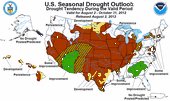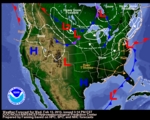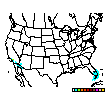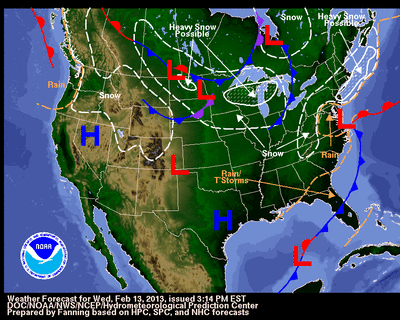Thu, 14 Feb 2013 07:19:00 EST
Light snows skirting the southern New England coast should come to an end Thursday morning as a quick moving coastal storm pushes farther out to sea. The tail end of the storm's cold-front, however, will stall over southern Florida and keep weather unsettled across the sunshine state. Weak energy aloft, moving through the northern Gulf of Mexico and towards the southeastern U.S. should help enhance precipitation along the stalled boundary, leading to periods of moderate to heavy rains, with embedded thunderstorms over the southern tip of Florida. Light snow showers are expected from the Dakotas to the Great Lakes.
Latest local weather forecasts, warnings, watches, and advisories...
Hydrometeorological Prediction Center Short Range Forecast Discussion


Fri, 08 Feb 2013 07:25:57 EST
Drought eased slightly in parts of the country from Hawaii to Virginia, intensified in other areas, and was nearly unchanged over the hardest-hit areas of the Plains, in the week that ended Feb. 5, according to the U.S. Drought Monitor. A powerful storm Jan. 29 and 30 brought much-needed precipitation to the Southeast and to parts of the South and southern Plains. Precipitation eased drought in some parts of the Midwest, particularly in areas where soils were not frozen and moisture could seep into the ground. Snowpack improved in some areas but is still below normal in much of the West. All Hawaiian islands have seen some improvement in drought after two weeks of good rain. Some states saw drought ease in some areas but intensify in others. Drought eased in western Colorado but intensified in the eastern part of the state, while in Oklahoma, drought intensified in the Panhandle but eased to the east.
Details...
 News from NOAA
News from NOAA
Contiguous United States warmer and wetter than average for JanuaryThu, 14 Feb 2013 13:10:00 -0500
According to NOAA scientists, the average temperature for the contiguous U.S. during January was 32.0°F, 1.6°F above the 20th century average, tying with 1958 as the 39th warmest January on record. Drought conditions remained entrenched across the Southeast, Great Plains, and the mountainous West.
Details...
















